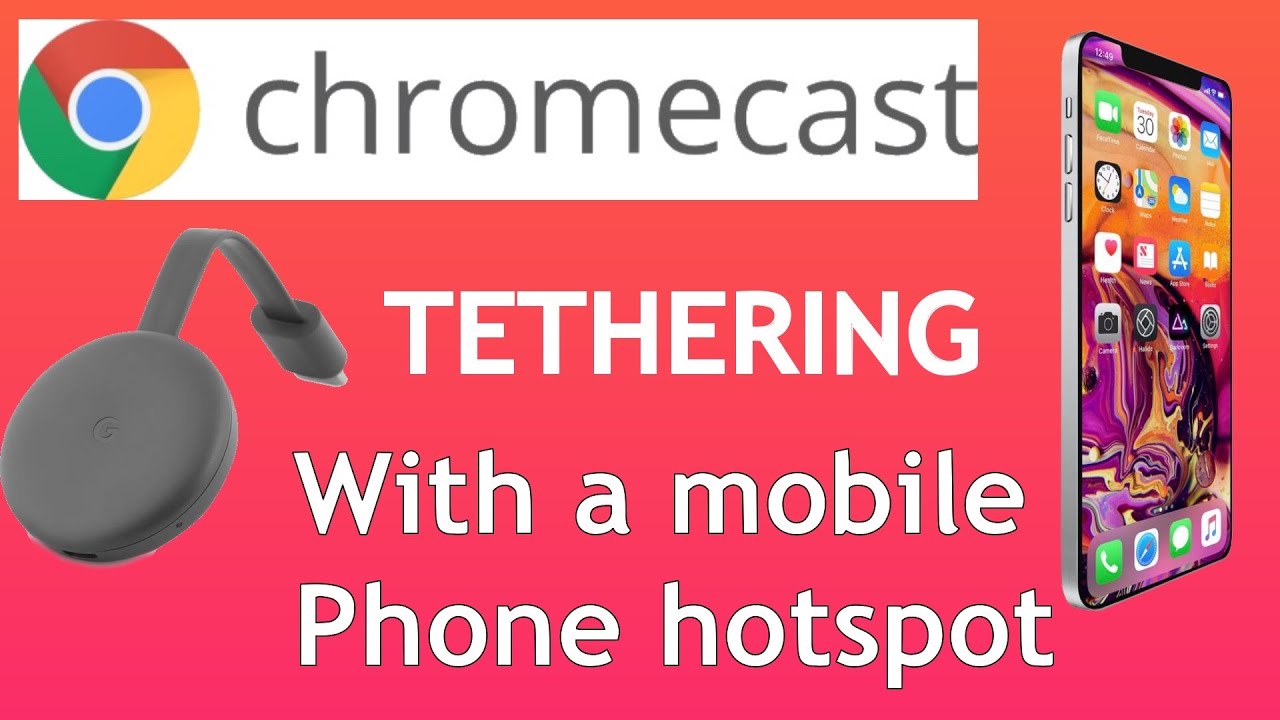How to Use Chromecast with Mobile Data – A Step-by-Step Guide

You may have wondered if it’s possible to use a Chromecast with the data from your mobile phone. This is possible, although it requires a certain arrangement where the mobile phone provides data for the Chromecast, while also accessing streaming apps like Netflix or Amazon Prime. This walkthrough will spell out how to accomplish this, using a secondary device, such as an Android phone, an iPhone, an iPad or a computer with a Chrome browser. Let’s get started! 😊
Ensure No Wi-Fi Connection
Before you start, make sure that there is no active Wi-Fi connection. You can do this by simply turning off the Wi-Fi on all devices involved. For demonstration purposes, we’re going for a scenario where the devices do not have their own data (no SIM card on the phone).
Connect Chromecast to TV
Proceed to plug the Chromecast into the TV. The screen should display a message indicating that the Chromecast cannot connect to Wi-Fi, because it is turned off.
Turn on Hotspot
Now, it’s time to turn on your hotspot, which becomes your personal hotspot. This action makes your hotspot active and ready to provide internet connection from your smartphone.
Setting up a Device on Google Home App
On your secondary device, go to the Google Home app. If you don’t have it installed, download it. Click on the app and navigate to add –> setup a device. You will be prompted to set up a new device in the home. Choose your TV (in this case, the Family Room TV) and follow the prompts for setup. The app should confirm connection and your TV will be connected to your iPhone’s Wi-Fi network 👍.
Make sure you have enough data
At this point, both the Chromecast and your Streaming device are connected to your phone’s hotspot. Ensure that your data plan can accommodate this arrangement. It’s important to ascertain how much data you’ll need, especially if you’ll be using this on a regular basis.
Activate Streaming
Time to start streaming! 🎉 Launch your preferred streaming app (whether that’s Netflix, Amazon Prime, iPlayer, etc) on the casting device. Each app typically has a ‘cast’ icon that enables streaming to your TV.
Chromecast Options
An added advantage is that your smartphone acts as a remote control for the streaming media, providing a seamless experience for controlling content playback on your TV 📳. Also worth noting are various Chromecast options and offers one can take advantage of, including free movies, subscription services, and remote control features.
Conclusion: 🏁
There you have it – using Chromecast with mobile data is possible and straight-forward! All it requires is a solid data plan, a casting device (be it a Chromebook, a Windows laptop, an Android phone, or an iPhone), and a bit of configuration on Google Home App. This guide walks you through each step of the process, to ensure you can enjoy your favorite shows even when Wi-Fi is out of reach. Happy streaming! 📺
FAQ
What is Chromecast?
Chromecast is a dongle-like device for your television, connecting to the TV’s HDMI port to add smart functions to your TV, like Netflix streaming, for example. It’s powered by a USB cable, and by connecting your smartphone or computer to your Chromecast, you can display what’s playing on your device screen to your TV display.
Can I use Chromecast with mobile data?
Yes, you can use Chromecast with mobile data. However, you might need to set up a portable hotspot to do this. Using Chromecast with mobile data could potentially use a lot of data, so it is recommended only if your mobile plan includes plenty of data usage.
What is a step-by-step guide to using Chromecast with mobile data?
This guide provides you the step-by-step process to use Chromecast with mobile data. The steps include setting up a portable hotspot, connecting Chromecast to your hotspot, and then streaming content to your Chromecast. More detailed instructions can be found in the main body of the article.
What do I need to set up Chromecast with mobile data?
You will need a Chromecast device, a TV with an HDMI port, a smartphone with a data connection and the ability to set up a portable hotspot, and the Google Home app.
How do I set up a portable hotspot?
You can set up a portable hotspot in the settings of your smartphone. It will typically be under ‘Network & Internet’ or similar. Once there, you can activate a portable hotspot and set a password for it.
How do I connect the Chromecast to my hotspot?
Once the portable hotspot is set up on your phone, you can connect your Chromecast to it. Do this by going into the Google Home app, selecting your Chromecast device, and then choosing the ‘WiFi’ option. From there, you can select your hotspot and enter the password you set up.
Why would I want to use Chromecast with mobile data?
Using Chromecast with mobile data could be useful if you do not have access to a stable WiFi connection, or if you are travelling and want to use your Chromecast in different locations.
Can I use Chromecast with any mobile network?
Yes, Chromecast can work with any mobile network. However, it is important to note that data charges will apply according to the terms of your mobile data package.
Can Chromecast work without WiFi?
Yes, Chromecast can work without WiFi, using your mobile data instead. However, setting this up requires you to create a portable hotspot with your mobile data.
Is using Chromecast with mobile data expensive?
Using Chromecast with mobile data could potentially use a lot of data, which could be expensive depending on your mobile data plan. It is recommended to check your data usage and the terms of your mobile data package before using Chromecast with mobile data.
Can I limit the amount of data used by Chromecast?
Chromecast itself does not have a data limiting feature. However, you can monitor and control your data usage on your smartphone, depending on your mobile operating system and mobile network provider.
Can multiple people use the same Chromecast with different mobile data?
Yes, as long as they are connected to the same hotspot, multiple people can control the same Chromecast using their own devices and mobile data.
Can I use Chromecast while roaming?
Yes, but it may incur high data charges, depending on your mobile network provider’s roaming policy. It’s essential to check the terms and conditions of your data plan before using Chromecast while roaming.
Why isn’t my Chromecast not connecting to my mobile hotspot?
There could be a few reasons why your Chromecast isn’t connecting to your mobile hotspot. This could be due to your hotspot not being set up correctly, your Chromecast not being set up correctly, connection or interference issues, or device compatibility issues.
Will casting my screen consume more data?
Yes, casting your screen or casting high-quality content can consume more data. If data usage is a concern, consider lowering the quality of your casting content.
Can I use Chromecast with a tablet?
Yes, Chromecast works with tablets. As long as your tablet can set up a mobile hotspot, you can use a Chromecast with it.
Is there a way to get Chromecast to automatically connect to my hotspot?
There’s no way to automatically connect Chromecast to your hotspot, but after you connect it once, it should remember your network for future use. This means you only need to select your hotspot once.
Can I use Chromecast with a limited data plan?
Yes, but be aware that high-quality streams, particularly those in HD or 4K, can consume a large amount of data. If you have a limited data plan, you will need to monitor your usage carefully.
How can I check the data usage of my Chromecast?
You can typically check this in the data usage settings of your smartphone. It might be listed under the name of your Chromecast, the Google Home App, or even under the individual apps that you have been streaming from.
Can I use different streaming apps with Chromecast?
Yes, Chromecast is compatible with a wide range of streaming apps, including Netflix, YouTube, Hulu, and many others. The specific availability of apps may depend on your location.
Can I cast content from my computer to Chromecast using mobile data?
Yes, if your computer has the ability to create a hotspot with its data connection, you can cast content from it to your Chromecast.
Does Chromecast support 3G and 4G networks?
Yes, Chromecast can use both 3G and 4G networks. However, be aware that streaming quality may be less good on slower 3G networks compared to 4G.
How can I secure my mobile hotspot?
You can secure your mobile hotspot by creating a strong, unique password for it. This can typically be done in the hotspot settings on your smartphone.
Can Chromecast be used with a mobile data dongle?
This depends on the specific model of the dongle and whether it can create a portable hotspot. If it can, then it should be possible to use the dongle with Chromecast.
Does using Chromecast consume battery life?
Yes, using Chromecast, particularly with mobile data and a hotspot, can consume a large amount of battery life. It is recommended to have your phone plugged into a power source if you are going to be casting for a long period.
Do I need the Google Home app to use Chromecast?
Yes, the Google Home app is the main app you use to control the Chromecast and is necessary to set up and operate Chromecast.
What devices are compatible with Chromecast?
Chromecast is compatible with Android devices, iPhones, iPads, Macs and Windows computers, and Chromebooks.
Can I use Chromecast with iOS devices?
Yes, Chromecast is compatible with iOS devices. However, the setup steps may be a bit different compared to Android devices.
How can I improve streaming quality when using Chromecast with mobile data?
To improve streaming quality, you can do several things: ensure you’re in an area with strong mobile data signal, use a 4G network rather than a slower 3G network if possible, limit other activities on your smartphone that might consume data (like background apps), and close other devices connected to your portable hotspot.
Do all streaming apps support mobile casting with Chromecast?
Most popular streaming apps are compatible with Chromecast, but it’s best to check with the specific app. Some apps may not support casting, or may only support it on certain devices or with certain subscriptions.
 ping.fm
ping.fm 